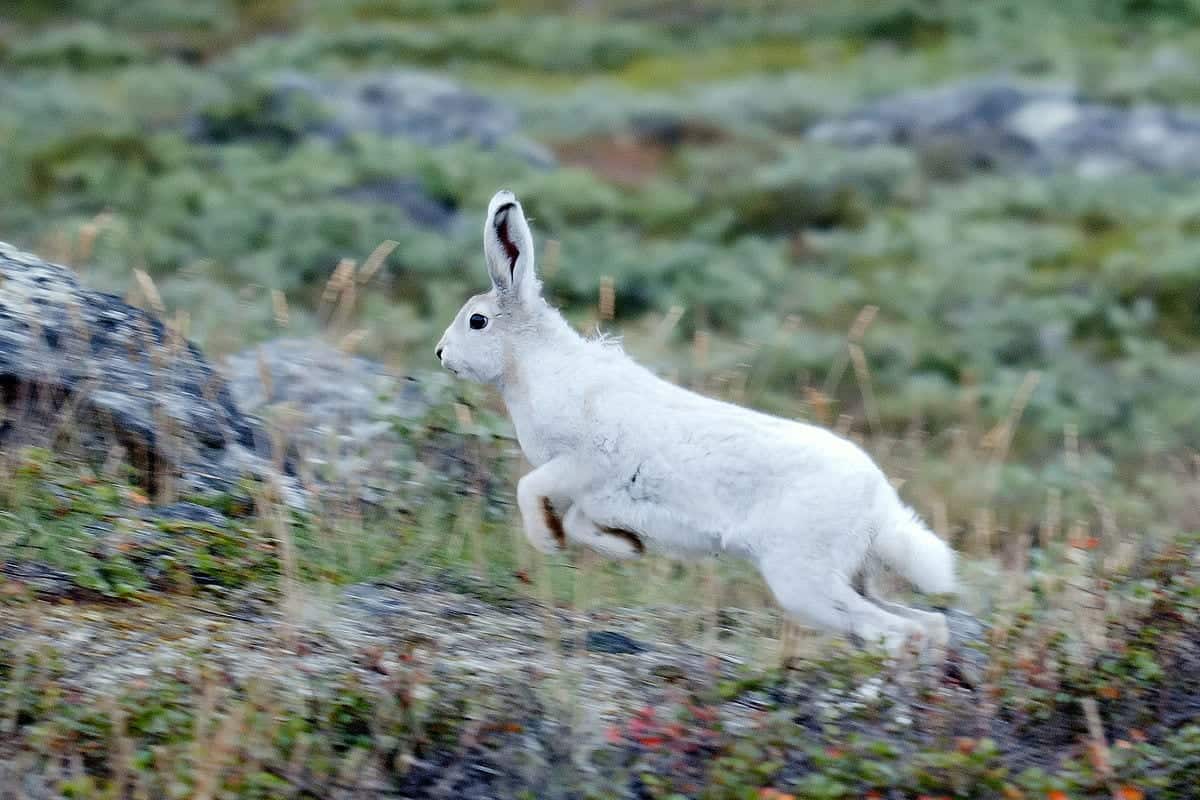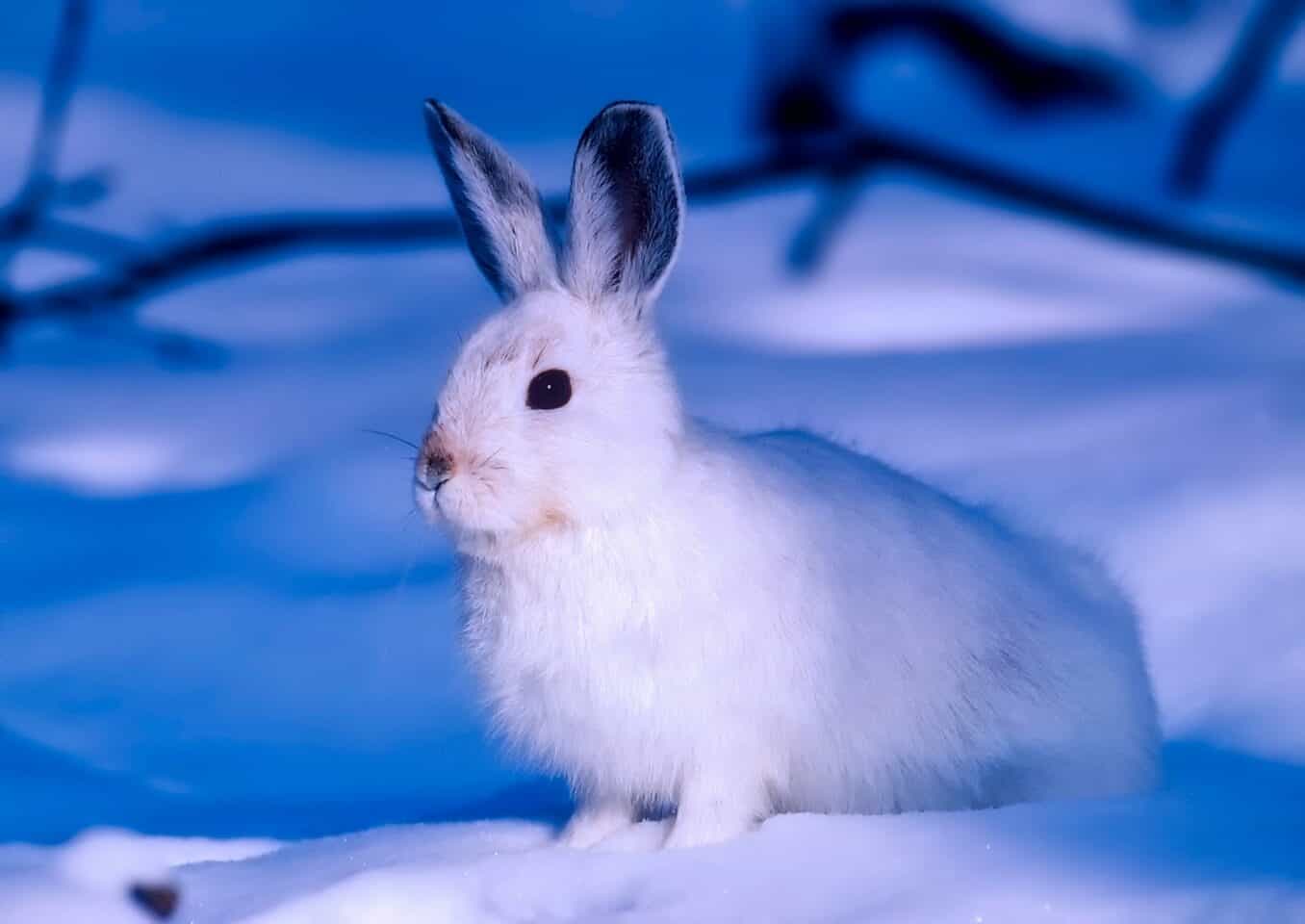Primarily found in Canada and Canadian territories, the Arctic Hare is one of the largest Hare species. It is well equipped to deal with life in sub-zero conditions, does not hibernate even during the coldest months, and although it typically eats leaves, some Arctic Hares have been witnessed eating fish and even the stomach contents of dead animals. The Hare has adapted to be able to cope with the cold conditions, sporting thick, insulated fur throughout the year, huddling together for warmth and digging holes in which to get warm and sleep.
Not much is known of the Arctic Hares’ numbers or conservation status, but the species is hunted by humans and is also prey to several animals including foxes, lynxes, wolves, and even large birds like peregrine falcons and snowy owls. Like most Hare species, the Arctic Hare is fast and agile, reaching speeds of up to 40 miles per hour and capable of jumping up to 2 meters in the air.
| Size: | 17-28 inches long |
| Weight: | 6–12 pounds |
| Lifespan: | 3–5 years |
| Similar Breeds: | Mountain Rabbit |
| Suitable for: | The wild |
| Temperament: | Typically solitary, shy, athletic |
There are approximately 30 species of hares across the world. They can be differentiated from rabbits by the fact they usually have longer ears and longer hind feet. Their tails, although short, are also longer than those of rabbits. Hares are also solitary creatures that spend most of the year alone, although they may come together for mating and breeding. In the case of the Arctic Hare, they may also group and huddle together for warmth. This is different from rabbits, which will form large groups and live together in warrens.
Compared to other species of hare, the Arctic Hare has longer claws that help dig in and get purchase on snow. They also have exceptionally powerful hind legs and longer incisors than most other species. The Arctic Hare is a large species of hare that has slightly shorter ears than most.

Arctic Hare Characteristics
[yasr_multiset setid=7]Can Arctic Hares Be Kept As Pets?
Arctic Hares are not considered suitable pets and should not be kept as such. Unlike rabbits, hares are very timid and do not take well to human handling and contact. Hares can also be aggressive, especially when they are not kept in ideal conditions.

Things to Know About the Arctic Hare:
Arctic Hares in the Wild
Arctic Hares are primarily found in Northern Canada. They are also found on Ellesmere Island, Newfoundland, Greenland, and the Arctic Islands of Canada. They live in cold, mountainous regions, where they live in rocky areas, and on the coasts. They are inactive during the day, coming alive in the evening and hunting at night. At times of year when the sun doesn’t rise, the hares do not have any set resting or waking periods.
The hares live between 3 and 5 years. Although they will live solitary lives, like most hares, they will also group together during mating season and may huddle together for warmth in winter months. Between April and September, males and females pair off and females can have one or two litters of 5 or 6 leverets per litter.
Young leverets are left by their mothers, who will only return every 18 hours or so to provide milk. The leverets are weaned completely by the age of 8 or 9 weeks and are sexually mature by the next year. Arctic Hares can reproduce quickly and in great numbers, which means that their numbers can swell significantly in a short space of time.
Arctic Hares are considered somewhat migratory, with populations moving south in winter and migrating back north in summer.
Prey and Predators
Arctic Hares are widely considered folivores, which means that they eat the leaves of plants. They especially eat moss, lichen, and twigs. They will also eat bark, leaves, and roots, depending on the season and availability of food. However, the harsh conditions in which they live mean that these animals have to compromise. They will eat berries and plants when they are available, and some have even been witnessed eating fish and occasionally snacking on the stomach contents of dead animals.
The species has adapted to life in very challenging conditions. As well as eating fish and reindeer stomachs, Arctic Hares have longer and sharper incisors than other hares. These long incisors make it possible to pull plants from difficult-to-reach positions.
The Arctic Hare is a prey animal. It is hunted by humans for its meat and its fur. It is also a popular source of food with foxes, including the Arctic and Red Fox; wolves; and large birds including Snowy Owls and Peregrine Falcons.
Arctic Hares’ Arctic Adaptations
While the Arctic Hare is a popular food source for a lot of wild animals, that doesn’t mean it is an easy meal. The species can reach speeds of up to 40 miles per hour. It can also jump in a similar way to Kangaroos, using just its back legs, and can reach heights of up to 2 meters while being able to turn sharply to get away from any threats.
The hare’s coat also acts as excellent camouflage. It is brilliant white in winter, matching the snowy backdrop. It will develop some blue-gray markings during spring, which camouflage against the rocks and other features that become apparent at this time of year.
It has also adapted to life in Arctic conditions. Approximately 20% of their body fat is used as insulation against the cold, and the Arctic Hare’s ears are shorter than other hares, which helps them retain more heat and prevents the extremities from getting cold. Even their paws are heavily coated in fur, which not only protects their paws but it helps spread the weight over a larger area so their feet don’t become enveloped by cold snow.
They are capable of quickly and effectively digging a hole under the snow, enabling them to get away from extremely cold temperatures, and although the species is a solitary animal, groups of Arctic Hares will live together and huddle for warmth in the especially cold winter months.

Arctic Hare Conservation Status
A survey of Arctic Hare populations determined that they were not under any current threat, and the IUCN has classified the species as being “Of Least Concern.”

4 Unique Facts About Arctic Hares
1. Their color is partially determined by their location
Although all Arctic Hares have a brilliant white coat during the winter months, to camouflage them against the snow, different groups have slightly different color coats in summer, according to where they live. Those in the North retain a brilliant white all year while those in the South develop a summer coat with brown sections to provide camouflage against rocks and tundra.
2. Arctic Hares are one of the biggest hare species
Hares are bigger than rabbits, in most cases, and the Arctic Hare is one of the biggest species of hares. Approximately 20% of the hare’s body weight is used to keep the animal warm during cold weather. Despite this, the Arctic Hare has shorter ears than most other hares.
3. They can see a full 360° field of vision
The placement of the Arctic Hare’s eyes means that they can see all the way in front and around the back of themselves without having to turn their head. This 360° field of vision means that the species can eat and relax while still being able to keep an eye out for approaching predators.
4. They have black eyelashes
Arctic Hares have many physical adaptations that enable them to better survive in cold weather. They have wide feet with plenty of fur padding and carry extra body weight to use as insulation. They even have black eyelashes, which help protect their eyes from the glare of the sun.

Conclusion
Arctic Hares are found in the North of Canada. They are highly adapted to living in sub-zero, Arctic conditions, with thick fur, extra body weight, and shorter ears that help maintain temperature. They are not kept as pets because, like most hares, they can be aggressive and they will not get along with human owners. Currently, they are considered “Of Least Concern” on the conservation watchlist, which is likely because they live in inhospitable, difficult lands where they are not yet under threat from human expansion.
However, they are hunted in relatively small numbers by people, for their meat and fur, and they are prey animals, which means they are hunted by predators including foxes and wolves.
Featured Image Credit: Sophia Granchinho, Shutterstock
